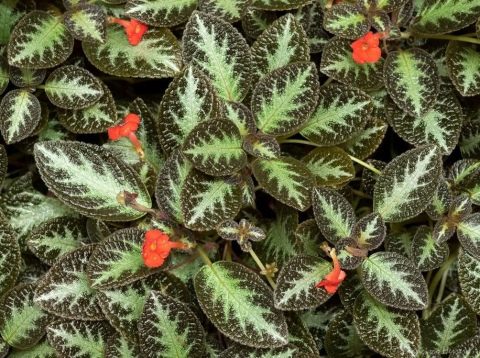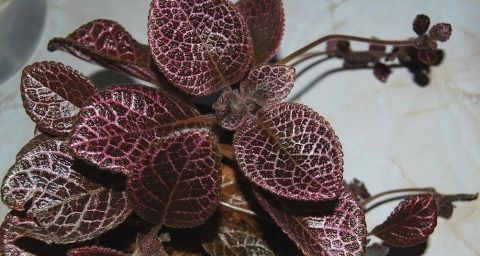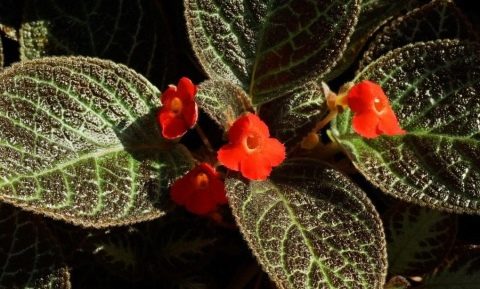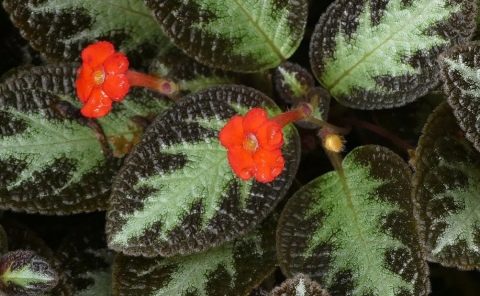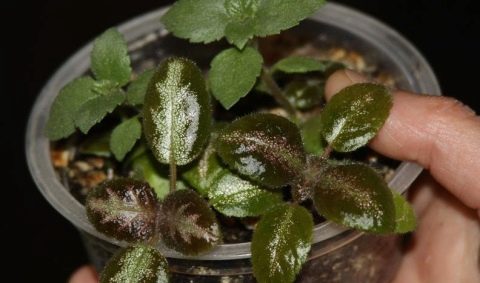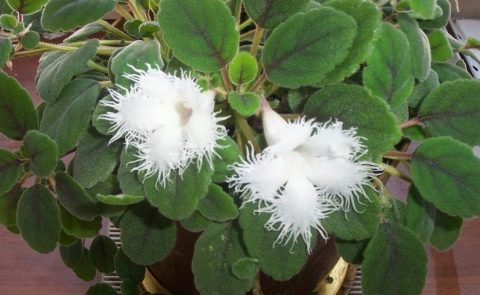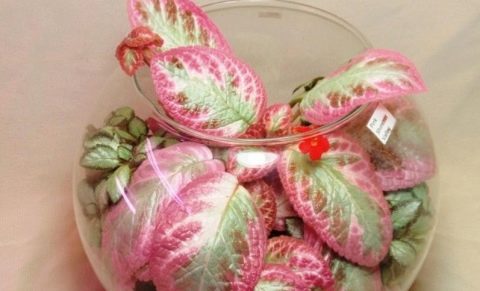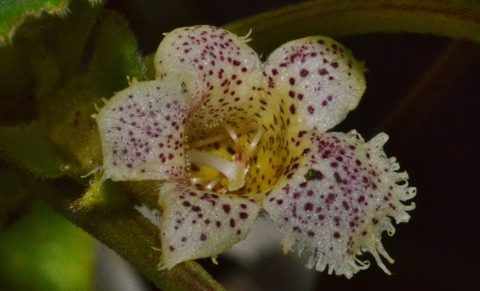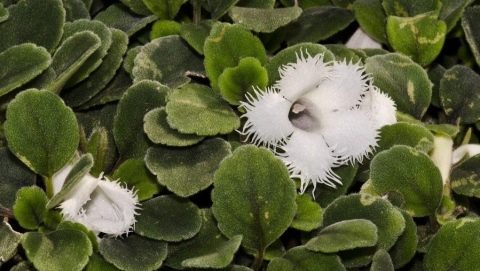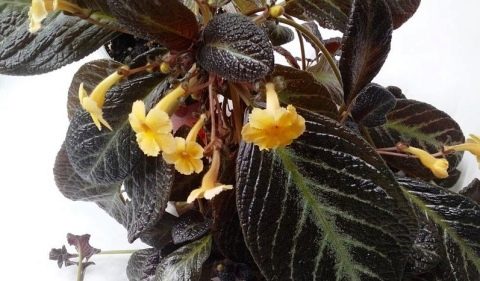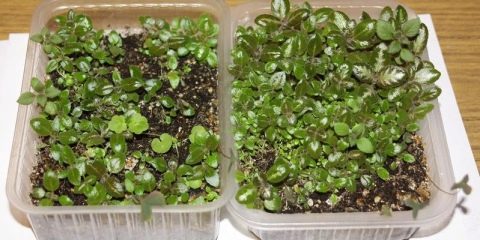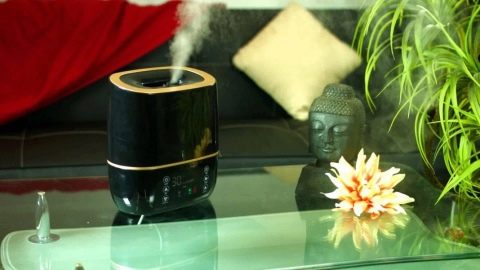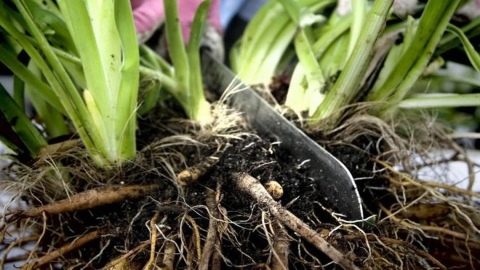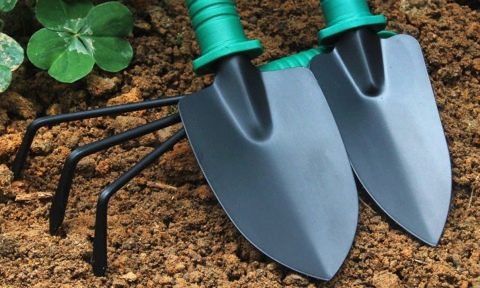Episation flower indoor
Episcia is a beautiful climbing perennial plant. In our climate, it is grown as an indoor flower. It can grow in the garden, but only in the warm season, it does not tolerate winter frosts.

Episode room
Distribution area
In nature, the episode grows in Brazil, Colombia, Mexico and other countries of South and Central America, where it is found in tropical forests, in shaded areas with high humidity.
Botanical description
Episcia is translated from Greek as "shaded". This makes it clear that the flower does not like direct sunlight and will feel good on northern windows or in a flowerpot on the wall. The plant belongs to the genus of perennial herbaceous plants. Root shoots are formed on its shoots, and in natural conditions the episode quickly spreads over the plot of land in different directions.
Leaves are the real pride of a flower. Their shape is ovoid with a pointed tip, but the colors and textures surprise and delight with beauty and variety. Leaves can be glossy or velvety, wrinkled or fluffy, one color with prominent veins, or two-colored. The color gamut of the leaves of the episode is very wide - from standard green shades (light green, emerald green, dark green, marsh, gray-green) to chocolate, copper, raspberry, pink, mother-of-pearl silver.

Epistia's mustache is a means of propagation
The flowers are not large, solitary, elongated, with four stamens. The colors also differ depending on the variety, there may be white, pink, red, yellow, and other shades. They bloom at home from June to September.
Plant care
Although the episode loves shaded places, the indoor flower needs good lighting so that the shoots do not stretch out, the leaves retain their decorative effect, and the flowering is abundant and long-lasting. Only sunlight should be diffused.
The plant feels good at high humidity, while it is recommended not to spray it, but to put it in a tray filled with expanded clay, and add water there. Watering the plant should also be done through the pallet. Water should be used at room temperature.
The flower is kept at room temperature 20-24 ° C. Prefers slightly acidic or neutral soil. Optimal soil composition:
- 1 part peat
- 2 parts of leafy soil,
- 1 part sand
- additionally, you can add charcoal.
In the spring and during the flowering period, the flower can be fed 1-2 times a month with mineral and organic fertilizers, but the concentration should be 2 times less than indicated on the package with additives, if you overdo it with fertilizer, the leaves of the flower will turn yellow. At the same time, the plant requires an annual transplant in the spring to avoid soil acidification.
Important! Pruning of the episode is carried out at will, as it grows, but after flowering. There is practically no rest period, ornamental leaves do not fall off and flaunt all year round
Reproduction
The weaving handsome man reproduces by seeds or shoots. Considering that the flower sprouts lateral shoots on which aerial roots grow, there are no problems with reproduction. You just need to break off the shoot, which already has roots, and put it in the water. When the roots grow a little, after about a week, the flower can already be transplanted into a pot. The container should not be deep, but wide, always with drainage.

Blooming Epistia
With proper care, timely watering, fertilization and transplantation, the episode practically does not get sick.She can only suffer from the appearance of harmful insects. Among them: aphids, thrips, whitefly, mealybugs, scale insects, which will have to be dealt with with the help of fungicides.
Episation is a beautiful, unpretentious indoor flower, which is not difficult to grow. It grows very quickly and, when favorable conditions are created, it grows with a lush weaving cap of decorative leaves with no less beautiful flowers.
Peculiarities
The fluffy leaves of this flower are covered with unusual patterns. Scientists named the plant episode, and the indigenous people of his homeland of South America gave it many other poetic names: violet flame, chameleon plant, peacock flower, orange or violet. Judging by these names, it is easy to understand that this flower is distinguished by its beauty and brightness. As a result of breeding work, various colors of the leaves appeared: silver, burgundy, purple, pearl and lime. The scattering of flowers makes this plant even more charming.
In its natural habitat, the creeping roots of the flower have underground shoots, and the stems cover the ground. Fibrous roots sprout with rosettes of leaves. They put on whiskers, which continue to reproduce the plant.
This flower has proven itself well as a home culture. The episode can be planted both as a potted plant and as an ampelous plant. First, young shoots rush up, and then scatter their foliage to the sides. They complement the interior especially successfully if they are planted in hanging pots at a high altitude.


The stem can be shorter or longer depending on the type of plant. It is dotted with closely-planted leaves with fluff. The leaves are elliptical or leaf-shaped. Flowers with four stamens have a variety of colors: red, purple, salmon, yellow, blue, blotches are allowed.
Caring for the Episation at home
Episation is not a capricious plant. But in order for her to delight with her beauty for a long time, she needs certain conditions.
Lighting. Location
Episode requires bright but diffused light. The most favorable place is the sill of the east or west window. If the pot with the plant is placed on the north side, it will not harm Episia, since it tolerates shade well. When growing a culture on a southern windowsill, it must be shaded with a curtain or a sheet of paper from direct sunlight, which can harm the foliage, spoil its decorative effect.
Air temperature
The air temperature in the room all year round should not be lower than + 18 ° С. The temperature in the range of + 20 ° С ... + 24 ° С is considered favorable. In autumn and winter, the plant must be protected from cold drafts.
Watering
It is necessary to water the Episation carefully so that water droplets do not fall on the leaf plates. It is best to water the plant through the drip tray. Water must be settled, at room temperature. In spring and summer, the plant needs regular and abundant watering. It is carried out as soon as the top layer of the substrate dries up. In autumn and winter, the amount of watering is reduced. During this period, the plant is watered 2 days after the topsoil has dried. Do not allow the earthen coma to dry out in the pot or stagnate water.
Air humidity
The Episode needs high air humidity, however, it is impossible to spray the Episode from a spray bottle, since water droplets falling on the pubescent surface of the leaves can cause rot. To increase the level of air humidity, it is recommended to fill the pallet with wet expanded clay, and put a pot with a plant on top, but in such a way that the bottom does not in any way come into contact with water.
Top dressing
During the growing season, Episation is fed 2 times monthly. Organic and mineral fertilizers are used, the consumption rate of which is reduced by 2 times from that recommended in the instructions. Fertilizers are desirable to alternate.
Experienced flower growers suggest feeding Episzia with a nutrient solution from yeast. To prepare it, you will need 10 g of yeast, 1 tablespoon of granulated sugar, 1 liter of warm water. The ingredients dissolve in water, the solution is infused for 2 hours. The soil is fertilized in a ratio of 1: 5.
Pruning
At home, Episation grows pretty quickly. So that the plant does not lose its decorative effect, it looks neat, its fast-growing shoots must be shortened.
If Episia is grown as an ampelous crop, the pots should be kept separate from other plants, since its stems quickly spread, they can capture a nearby flower pot. To prevent this, the stems must be cut periodically.
Transfer
Every year in the spring, Episia is transplanted into a new flower pot, which must necessarily be low, but wide, and have drainage holes. The plant prefers a slightly acidic with a pH of 5.5-6.5 or a neutral substrate. It should consist of leafy soil, peat and river sand, taken in a 2: 1: 1 ratio. It is also recommended to add some woody angle and moss to the substrate.
How to grow an episode at home?
This exotic flower is ideal for self-germination, because the care of the episode is simple. The plant reproduces in 3 ways, let's look at them.
Growing from seeds
With this type of reproduction, varietal characteristics are lost in 90% of cases.
The seeds are planted in the soil in January. If you want to see red, pink or yellow flowers of the episode next year, then plant in June. The seeds are simply laid out on the substrate without sprinkling with earth, the container with them is covered with glass or film.
And then expect seedlings, they will appear after 12 days. After 20–30 days, young Episation bushes are transplanted into separate pots.
The easiest way to reproduce is layering
For propagation by layering, choose rosettes located in the immediate vicinity of the mother flower. Long rosettes are difficult to root and do not take root well. After cutting, the layering is immediately immersed in the soil, added dropwise and kept under a film, like seeds. You can also immerse them in a glass of water before the first roots appear. Rooting takes 3 to 5 weeks.
Reproduction of the episode by antennae, stem cuttings or leaves
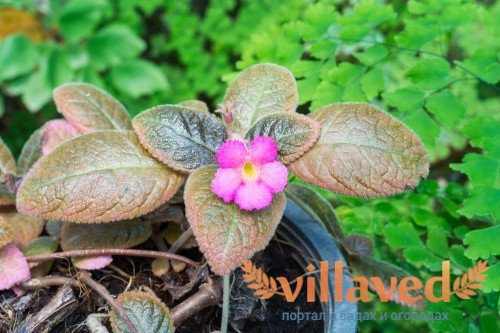
Episcia
Reproduction by antennae is carried out by cutting them off from the mother plant. The germination method is the same as for layering. But one antenna is divided into 2-3 parts, depending on its length.
You can also root a stalk or leaf. Cut them on the mother plant, treat them with "Kornevin" and submerge them in the soil from a mixture of deciduous soil, sand and peat.
You can buy seeds in the store, and cuttings and cuttings are freely available from amateur gardeners.
The most interesting varieties of this species with a photo
Homeland of "pure" species - Mexico (less often - Brazil, Venezuela, Colombia). However, in our time there are many episodes derived by gardeners from different countries. I have been collecting photos for a long time and finally I can show the best, popular and simply beautiful varieties of this species.
Episation carnation
The leaves of the flower are almost unremarkable - green and soft, round and small ... But flowers - white with thinly "cut" petals - this is something! By the way, they are single.
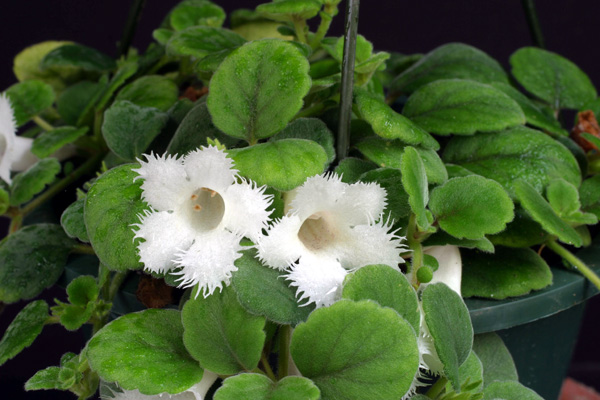
Lilac
It has soft dark green leaves with light green "hearts". Its flowers, as you might guess, are light blue, lilac (a rather rare color for this species). They can also be almost white with a yellow center.
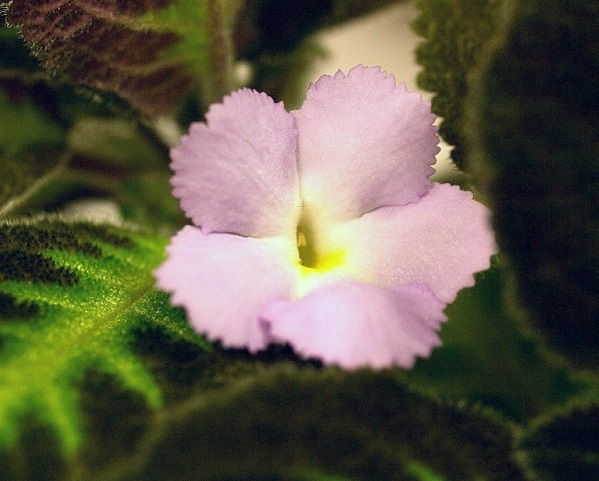
Creeping
The variety has many shoots. Decorated with oval, abundantly pubescent, not small leaves. Their color is dark at the edges, in the center - gray-green. The flowers are single, red.
Blooms from July to September.
Copper (copper-red)
In our country, this is probably the most popular variety. It is "clean", that is, it was brought from distant countries.However, it has become a "mother" for many hybrid sub-varieties, which you will learn about below.
Leaves are elliptical, dark, with barely noticeable light streaks. The flowers are red, sometimes with white spots inside.
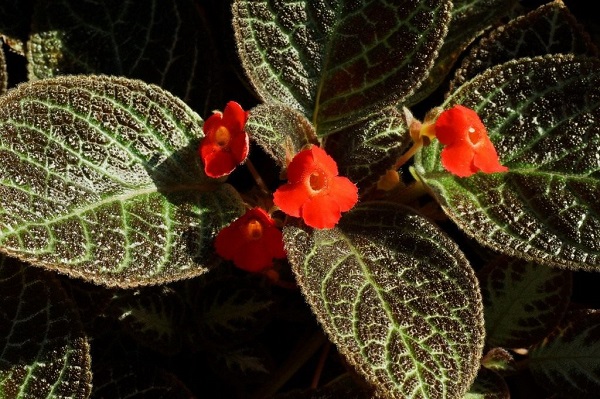
It blooms in summer, sometimes in the first month of autumn.
Silver shine (Silvershine)
A relative of the copper episode (hybrid).
Its leaves, as you might guess from the name, are silvery. All of them are decorated with edging, have spots, a green-brown border. The flowers are red, sometimes slightly orange.
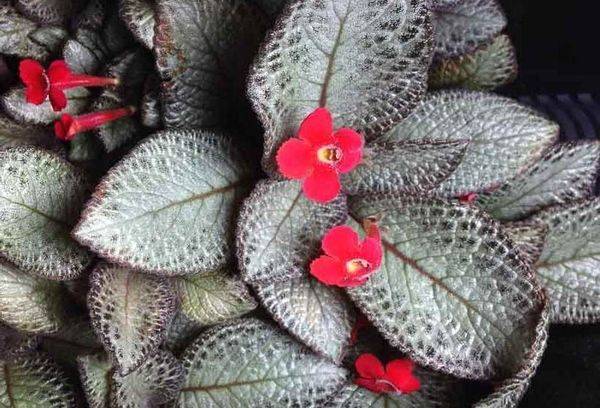
Forest Beauty (Sylvanas Beauty)
Another "sister" of the copper description.
Its leaves also have a silvery color, but they are no longer fluffy, but smooth. The flowers are red, rarely pinkish.
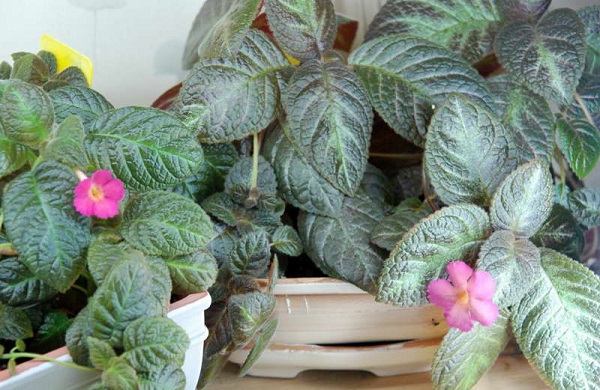
Blue Nile
Another successful "version" of the copper episode.
True, this time the flowers of the plant are blue. The leaves look very interesting, dark at the edges and light in the center, with a distinct pattern of veins.

Pink topaz
The last on our list is a sub-grade of copper episode.
This plant has pale pink flowers. But more than that: its leaves, especially young ones, are pink. Moreover, the leaves are not fluffy, but shiny.
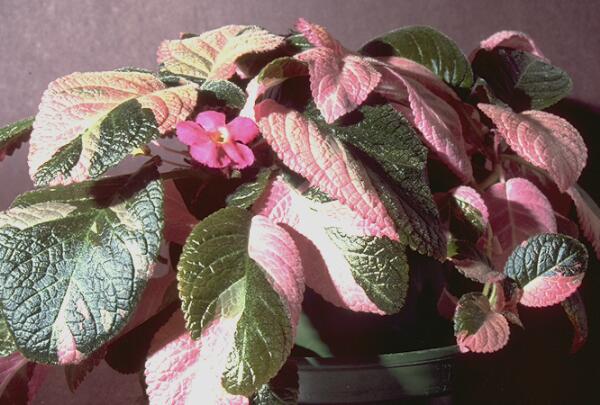
Strawberry haze (Strawberry patch)
A variety with completely pink leaves. It is curious that young leaves can be green, but later they turn pink. It blooms with small unexpected orange flowers with a yellow center.
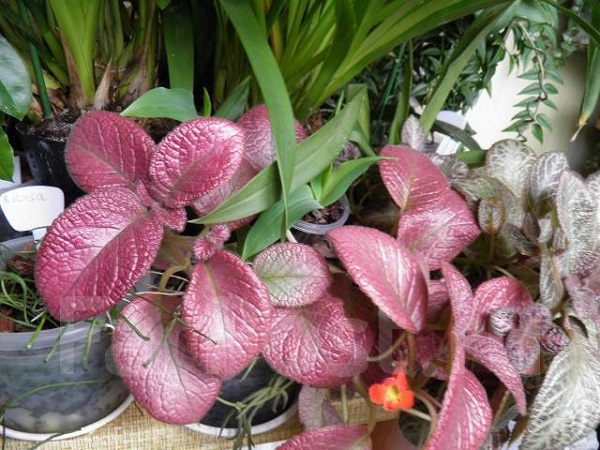
Chocolate Soldier (Choclette Soldier)
The name suggests that the leaves of the plant are brown. The "soldier" blooms with red flowers, and several flowers cling to one peduncle at once. This variety is considered to be richly blooming.

Cleopatra
The most unexpected and contrasting of its kind.
The flower has leaves along the edge - pink, further - with white stripes and brown spots, and green in the center. At the same time, it blooms with rare scarlet flowers.
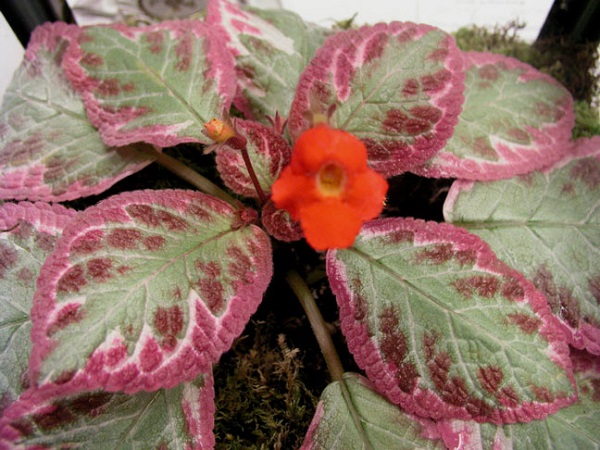
Diseases and pests
Like any other plant, the episode can get sick. This rarely happens, since the flower is all patient. But a caring owner should carefully examine his pet and take appropriate measures at the first warning signs.
- Episation leaves dry and turn yellow, if there are few nutrients in the soil, the plant begins to experience hunger. Spots of a yellow tint with brown edges appear when the leaves are burned from direct sunlight. Move the pot to a different location or feed it organic.
- Brown, dense spots on the leaf plates mean that the flower was watered with too cold water. Monitor fluid temperature.
- A gray film on the leaves and stems indicates a fungal bloom. Too stale air in the room, acidified or old substrate can lead to this. Transplant the flower to a different soil.
- The leaves curl and fall off when the flower is damaged by a parasite or dried out by the sun. Move the pot away from the light source and use insect remover.
Of the pests, mealybugs, aphids and root nematodes most often attack the episode.
 Root nematodes are small insects, but the most dangerous of all.
Root nematodes are small insects, but the most dangerous of all.
They reach only 1.3 mm in length, but they deftly migrate in the soil and infect leaves, stems, and roots, sucking out the juice and causing the appearance of gall-like thickenings. The plant stops growing, the roots die off, the leaves dry out.
To reduce the risk, do not use untreated garden soil for planting plants - be sure to heat it in the oven for half an hour or keep it in the freezer for a day.
You can destroy nematodes like this:
- Spray the plant with a solution of phosphamide, ruskamen or mercaptophos (dosage - 0.02%, 2-4 times with an interval of 3-5 days). This helps kill adults, but unfortunately not eggs.
- Wash the roots in water at a temperature of 50-55 degrees (this degree is safe for plants, and kills pests).
- Use the drug "Metarizin", "Nematofagin-Mikopro", "Lindane", "Chloropicrin"
Aphids, like a nematode, suck out juices, causing deformation of leaves, drying of shoots, and dropping of buds. Popular means for getting rid of the pest: Tanrek, Aktara, Iskra, Fitoverm, Trichopol, Aktofit, Jaguar, Fufanon. Follow the instructions and carry out the treatment, protecting the mucous membranes and respiratory organs with glasses and a special mask.
Popular types of epics
Episcia dianthiflora
Synonym: Alsobia dianthiflora (Alsobia dianthiflora) - allocated in a separate genus Alsobia. The homeland of the plant is Mexico. Perennial tropical plant with two types of shoots: shortened with closely spaced leaves and long, thin, darkening with age, rooting in nodes (whiskers), bearing daughter rosettes.
Leaves are small, 3 cm long, 2 cm wide, elliptical to ovate, crenate along the edge, dark green with a purple midrib, short velvety pubescent. The flowers are solitary, white with purple dots in the fauces and fringed along the edge of the limb lobes. There are a number of highly decorative varieties.
Episcia cupreata
Grows in shady places, at an altitude of 2000 m above sea level, in tropical rainforests in Colombia, Venezuela, Brazil. Perennial herb, is much larger than the previous species. Creeping shoots, easily rooting in the substrate.
Leaves are elliptical, rounded-elliptical, almost cordate at the base, 6-13 cm long and 4-8 cm wide, densely pubescent; from above brown-green to copper, with a wide white stripe along the midvein and in spots, from below - reddish, with a green stripe in the middle. Flowers are solitary, fiery red or scarlet red; corolla tube 2-2.5 cm long, yellow inside and with red spots, outside - red. Blooms in summer, July-September.
It is actively used when crossing and has many cultural forms and varieties:
- with very large (11-14 cm) leaves, brownish-olive, shiny above, greenish-silvery along the veins, pinkish below;
- with silvery-gray-green leaves, shiny, with a brownish-olive edge and spots between the veins, pinkish below along the edge;
- with large leaves, brownish-olive, soft pubescent, with a wide bright copper stripe along the midrib;
- with leaves rigidly pubescent, silvery-greenish with a brownish-green edge and spots between lateral veins;
- with smooth, light green leaves with silvery stripes along the middle and lateral veins.
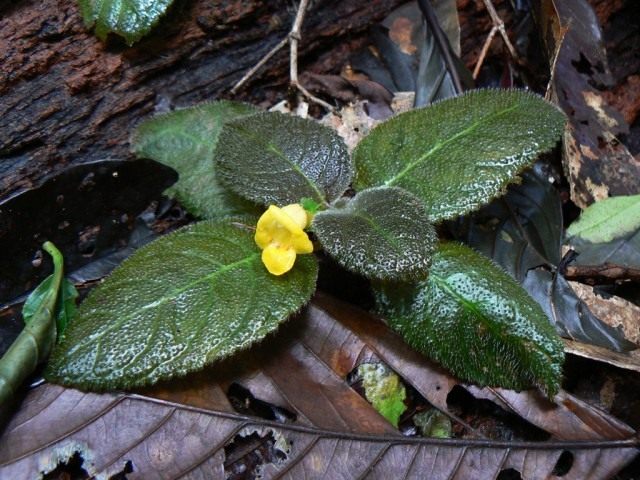 Episcia xantha. RNR Trésor
Episcia xantha. RNR Trésor
Episcia reptans
Found in shady places in tropical rain forests in Brazil, Colombia, Guiana, Suriname. Perennial herbaceous plants. Shoots are creeping, long, branched. Leaves are elliptical, 4-8 cm long and 2-5 cm wide, cordate at the base, densely pubescent, olive-green and brown above, reddish below, slightly wrinkled above, serrate-ciliate along the edges; along the middle vein and up to half the length at the lateral veins with a narrow silvery-green stripe.
Flowers are solitary, located in leaf axils, on red pedicels; corolla tube 2.5-3.5 cm long; corolla pharynx 2 cm in diameter, pink inside, red outside. Blooms in July-September. It is widely used as an ampelous plant.


